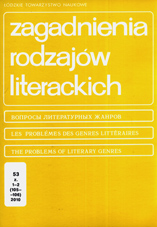Devices of Irony in the Late Medieval Vision: the Case of Geoffrey Chaucer's “Parliament of Fowls"
Devices of Irony in the Late Medieval Vision: the Case of Geoffrey Chaucer's “Parliament of Fowls"
Author(s): Katarzyna PytelSubject(s): Literary Texts
Published by: Łódzkie Towarzystwo Naukowe
Summary/Abstract: One of the central features of irony is the critical distance it demands from the reader, which stands in direct contrast to all forms of encoded empathy, attachment or commitment. Approached from this angle, irony is found to permeate the poetic structure of the Parliament of Fowls at a deep level, emerging in various constituents of the text. It is already visible in the composition of the poem, which consists of three large sequences: the proem with the dream of Scipio and the dream proper, which is subdivided into two parts: one devoted to the garden of love, and the other to the parliament of birds presided over by goddess Nature. Each section is devoted to a different notion of love, which is grounded within a larger conceptual framework, and written in a contrastive aesthetics. The very presence of three differing concepts of love and poetics in one poem disallows easy acceptance and ready commitment to any of them. On the contrary, it generates a critical distance, one of irony's prerequisites. The ironic mode visible in the composition is further developed by a number of devices that, used consistently throughout the poem, modify all of its elements.
Journal: Zagadnienia Rodzajów Literackich
- Issue Year: 53/2010
- Issue No: 1-2
- Page Range: 195-208
- Page Count: 14
- Language: English

